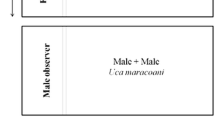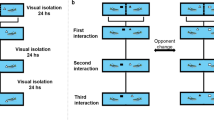Abstract
Aggressive interactions between animals often occur in the presence of third parties. By observing aggressive signalling interactions, bystanders may eavesdrop and gain relevant information about conspecifics without the costs of interacting. On the other hand, interactants may also adjust their behaviour when an audience is present. This study aimed to test how knowledge about fighting ability of an audience affects aggressive interactions in male Siamese fighting fish. Subjects were positioned between two dyads of non-interacting males and allowed to observe both dyads shortly before the view to one of the dyads was blocked, and the dyads were allowed to interact. Subjects were subsequently exposed to an unknown opponent in the presence of either the winner or the loser of the seen or unseen interaction. The results suggest a complex role of the characteristic of an audience in the agonistic behaviours of a subject engaged in an interaction. The presence of a seen audience elicited more aggressive displays towards the opponent if the audience was a loser. This response was different in the presence of an unseen audience. Subjects then directed a higher aggressiveness against their opponent if the audience was a winner. These results also suggest a potentially more complex and interesting process allowing individuals to gain information about the quality and threat level of an unknown audience while it is interacting with a third party. The importance of information acquisition for an individual to adapt its behaviour and the role of communication networks in shaping social interactions are discussed.


Similar content being viewed by others
References
Aquiloni L, Gherardi F (2010) Crayfish females eavesdrop on fighting males and use smell and sight to recognize the identity of the winner. Anim Behav 79:265–269
Aquiloni L, Buřič M, Gherardi F (2008) Crayfish females eavesdrop on fighting males before choosing the dominant mate. Curr Biol 18:462–463
Baltz AP, Clark AB (1997) Extra-pair courtship behaviour of male budgerigars and the effect of an audience. Anim Behav 53:1017–1024
Bierbach D, Girndt A, Hamfler S, Klein M, Mücksch F, Penshorn M, Schwinn M, Zimmer C, Schlupp I, Streit B (2011) Male fish use prior knowledge about rivals to adjust their mate choice. Biol Lett 7:349–351
Blakeslee C, McRobert SP, Brown AC, Clotfelter ED (2009) The effect of body coloration and group size on social partner preferences in female fighting fish (Betta splendens). Behav Process 80:157–161
Cheney DL, Seyfarth RM (2005) Social complexity and the information acquired during eavesdropping by primates and other animals. In: McGregor PK (ed) Animal communication networks. Cambridge University Press, Cambridge, pp 583–603
Clotfelter ED, Ardia DR, McGraw KJ (2007) Red fish, blue fish: trade-offs between pigmentation and immunity in Betta splendens. Behav Ecol 18:1139–1145
Crockford C, Wittig RM, Seyfarth RM, Cheney DL (2007) Baboons eavesdrop to deduce mating opportunities. Anim Behav 73:885–890
Doutrelant C, McGregor PK (2000) Eavesdropping and mate choice in female fighting fish. Behaviour 137:1655–1669
Doutrelant C, McGregor PK, Oliveira RF (2001) The effect of an audience on intrasexual communication in male Siamese fighting fish, Betta splendens. Behav Ecol 12:283–286
Dzieweczynski TL, Walsh MM (2011) Audience type and receptivity affect male–female interactions in Siamese fighting fish. Ethology 117:10–18
Dzieweczynski TL, Earley RL, Green TM, Rowland WJ (2005) Audience effect is context dependent in Siamese fighting fish, Betta splendens. Behav Ecol 16:1025–1030
Dzieweczynski TL, Bessler AM, Shelton DS, Rowland WJ (2006) Effect of a dummy audience on male–male interactions in Siamese fighting fish, Betta splendens. Ethology 112:127–133
Dzieweczynski TL, Gill CE, Perazio CE (2012) Opponent familiarity influences the audience effect in male–male interactions in Siamese fighting fish. Anim Behav 83:1219–1224
Earley RL, Dugatkin LA (2002) Eavesdropping on visual cues in green swordtail (Xiphophorus helleri) fights: a case for networking. Proc R Soc Lond B 269:943–952
Earley RL, Tinsley M, Dugatkin LA (2003) To see or not to see: does previewing a future opponent affect the contest behaviour of green swordtail males (Xiphophorus helleri)? Naturwissenschaften 90:226–230
Grabowski JG, Thompson T (1968) Effects of visual reinforcer brightness and color on operant behavior of Siamese fighting fish. Psychonom Sci 11:111–112
Hsu Y, Earley RL, Wolf LL (2006) Modulation of aggressive behaviour by fighting experience: mechanisms and contest outcomes. Biol Rev 81:33–74
Johnstone RA (2001) Eavesdropping and animal conflict. PNAS. 98:9177–9180
Karino K, Someya C (2007) The influence of sex, line, and fight experience on aggressiveness of the Siamese fighting fish in intrasexual competition. Behav Proc 75:283–289
Keddy Hector AC, Seyfarth RM, Raleigh MJ (1989) Male parental care, female choice and the effect of an audience in vervet monkeys. Anim Behav 38:262–271
Matessi G, Matos RJ, Dabelsteen T (2008) Communication in social networks of territorial animals: networking at different levels in birds and other systems. In: D’Ettore P, Hughes DP (eds) Sociobiology of communication: an interdisciplinary perspective. Oxford University Press, USA, pp 33–53
Matessi G, Matos RJ, Peake TM, McGregor PK, Dabelsteen T (2010) Effects of social environment and personality on communication in male Siamese fighting fish in an artificial network. Anim Behav 79:43–49
Matos RJ, McGregor PK (2002) The effect of the sex of an audience on male–male displays of Siamese fighting fish (Betta splendens). Behaviour 139:1211–1221
Matos RJ, Schlupp I (2005) Performing in front of an audience: signallers and the social environment. In: McGregor PK (ed) Animal communication networks. Cambridge University Press, Cambridge, pp 63–83
Matos RJ, Peake TM, McGregor PK (2003) Timing of presentation of an audience: aggressive priming and audience effects in male displays of Siamese fighting fish (Betta splendens). Behav Process 63:53–61
McGregor PK, Dabelsteen T (1996) Communication network. In: Kroodsma DE, Miller EH (eds) Ecology and evolution of acoustic communication in birds. Cornell University Press, Ithaca, pp 409–425
McGregor PK, Peake TM (2000) Communication networks: social environments for receiving and signalling behaviour. Acta Ethol 2:71–81
McGregor PK, Peake TM, Lampe HM (2001) Fighting fish Betta splendens extract relative information from apparent interactions: what happens when what you see is not what you get. Anim Behav 62:1059–1065
Mennill DJ, Ratckiffe LM, Boag PT (2002) Female eavesdropping on male song contests in songbirds. Science 296(5569):873
Neat FC, Taylor AC, Huntingford FA (1998) Proximate costs of fighting in male cichlid fish: the role of injuries and energy metabolism. Anim Behav 55:875–882
Noldus (1996) The Observer, Base package for Windows, version 3.0. Noldus Information Technology, Wageningen, The Netherlands
Oliveira RF, McGregor PK, Latruffe C (1998) Know thine enemy: fighting fish gather information from observing conspecific interactions. Proc R Soc Lond B 265:1045–1049
Peake TM (2005) Eavesdropping in communication networks. In: McGregor PK (ed) Animal communication networks. Cambridge University Press, Cambridge, pp 13–37
Peake TM, McGregor PK (2004) Information and aggression in fishes. –. Learning and Behavior 32(1):114–121
Peake TM, Terry AMR, McGregor PK, Dabelsteen T (2001) Male great tits eavesdrop on simulated male-to-male vocal interactions. Proc R Soc Lond B 268:1183–1187
Peake TM, Terry AMR, McGregor PK, Dabelsteen T (2002) Do great tits assess rivals by combining direct experience with information gathered by eavesdropping? Proc R Soc Lond B 269:1925–1929
Peake TM, Matos RJ, McGregor PK (2006) Effects of manipulated aggressive “interactions” on bystanding male fighting fish, Betta splendens. Anim Behav 72:1013–1020
Ribowski A, Franck D (1993) Subordinate swordtail males escalate faster than dominants: a failure of the social conditioning principle. Aggr Behav 19:223–229
Simpson MJA (1968) The display of the Siamese fighting fish Betta splendens. Anim Behav Monogr 1:1–73
StatSoft, Inc (2001) STATISTICA (data analysis software system), version 6, www.statsoft.com
Acknowledgments
We thank Giuliano Matessi for valuable comments and input. We are grateful to Sarah Till Boysen and two anonymous reviewers for their comments on a previous version of this manuscript. This research was supported by a Framework Grant (no. 272-07-0477) from the Danish National Research Council to TD. RM was supported by Fundacao para a Ciência e Tecnologia (Post Doctoral Grant SFRH/BPD/12872/2003).
Author information
Authors and Affiliations
Corresponding author
Rights and permissions
About this article
Cite this article
Bertucci, F., Matos, R.J. & Dabelsteen, T. Knowing your audience affects male–male interactions in Siamese fighting fish (Betta splendens). Anim Cogn 17, 229–236 (2014). https://doi.org/10.1007/s10071-013-0655-6
Received:
Revised:
Accepted:
Published:
Issue Date:
DOI: https://doi.org/10.1007/s10071-013-0655-6




